1
Bounty of the land, a successful huntCirca 1915
Benchlands of the Kettle River Valley
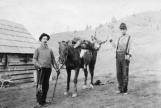 Credits:
Credits:Kettle River Museum
Donated by William Moll, 1978
2
"In our sparsely populated country of earlier days, wildlife was abundant, and the hunter's appetite for his limit of game was easily satisfied. Deer could be seen in all seasons of the year and when felling the large fire trees for firewood in wintertime, the snow would be packed down by the animals feeding on moss. Toward spring, as the snow left the steep side hills, the deer could be seen in great numbers savouring the new grass shoots."- from "A Harvest of Memories" by Bill Hatton, 1985
3
"...wildlife was abundant, and the hunter's appetite for his limit of game was easily satisfied"Date unknown
Benchlands of the Kettle River Valley
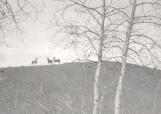 Credits:
Credits:Kettle River Museum
4
Hauling a heavy load in Christian ValleyDate unknown
The Kettle River and its tributaries
 Credits:
Credits:Kettle River Museum
Donated by Mrs. Rae Lee, 1994
5
"Due to much mining and logging activity, the towns became heavily populated... When the towns were booming they provided a good market for nearly all the farm produce raised over a wide area, especially beef which active men in the mines and woods would need in large quantities.The road was very steep and rough in the early days and needed a four horse team to negotiate the grade. There was very little other market for farm produce so the long four-day trip from home was undertaken at regular intervals. The horses would weigh around one thousand pounds apiece and were strong enough to haul the load and yet light enough to trot along on the level."
- from "A Harvest of Memories" by Bill Hatton, 1985
6
Hardy & Co. General Merchants became The Midway Store, then McMynn'sCirca 1910
Midway, BC
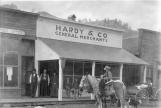 Credits:
Credits:Kettle River Museum
Nora Eveleth for the Jackson family, 1979
7
Herding sheep on the Boltz Farm1911
Midway, BC
 Credits:
Credits:Kettle River Museum
Donated by Rose Boltz, 2008
8
"There were some small flocks of sheep kept on the few farms in the 1920's and 1930's. On our own farm this was mostly for home consumption. Surplus lamb and mutton was sold and shipped to the mining camp at Beaverdell, and to butcher shops at Greenwood and Grand Forks. Wool was peddled to the Doukhobors in the Grand Forks area, who were eager to buy the long fibre of the Lincoln breed, which we raised. Socks and sweaters made from this wool lasted three times as long as wool from the short wool breeds."- from "A Harvest of Memories" by Bill Hatton, 1985
9
Falling a Ponderosa pine with a cross-cut sawCirca 1915
The Kettle River Valley
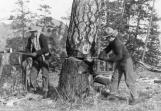 Credits:
Credits:Kettle River Museum, Sonny Jackson collection
Donated by the estate of Mike Downing, 1977
10
"In addition to the limited amount of agriculture there was great activity in the woods. This was mostly winter work, with the good timber adjacent to the river hauled by teams to the riverbank and stacked in great piles to await the spring break-up and ice-free river. When the river opened up the log drive would begin.I worked in a logging camp for a short period. I worked as a swamper, limbing the logs in readiness for the skidding team to haul them away to a landing for loading on sleighs. With snow three feet deep it was tough going for both men and horses. We were dealing with large logs up to sixteen feet long and four feet across on the butt, with two heavily built skidding horses to move and take them away. Strong, heavy sleighs were used to haul the logs to the riverbank to await the spring log drive."
- from "A Harvest of Memories" by Bill Hatton, 1985
11
Horse logging at Myer's CreekCirca 1915
The Kettle River and its tributaries
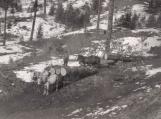 Credits:
Credits:Kettle River Museum
Donated by Mr. Wilson, 1986
12
Skidding logs to the riverbankThe Kettle River Valley
 Credits:
Credits:Kettle River Museum
Donated by Mr. Wilson, 1986
13
Gathering for the start of the log driveCirca 1915
The Kettle River
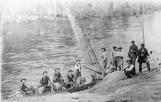 Credits:
Credits:Kettle River Museum, Sonny Jackson collection
Donated by the estate of Mike Downing, 1977
14
Waiting for the log drive to get underwayCirca 1915
The Kettle River
 Credits:
Credits:Kettle River Museum
Donated by Mrs. Rae Lee, 1996